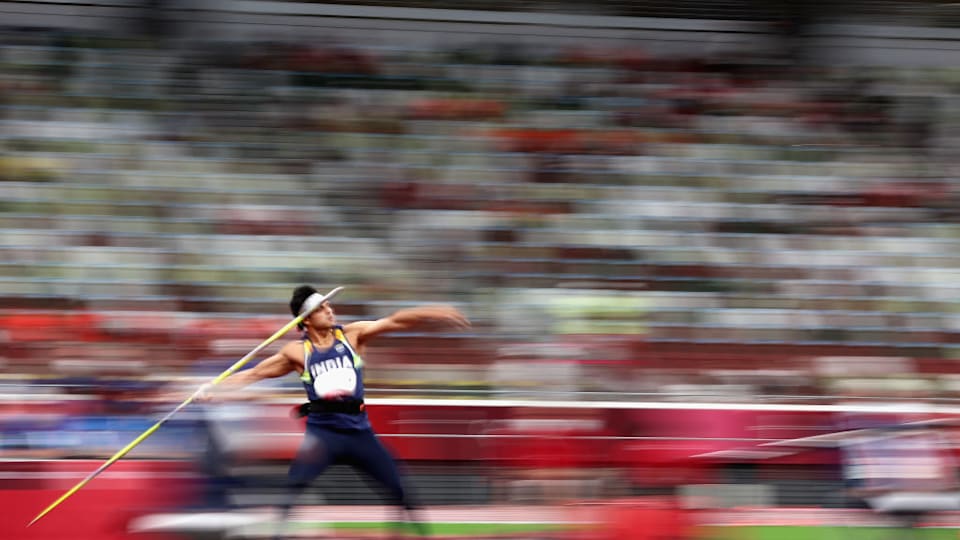How To Throw A Turbo Javelin
Javelin throw: Know the rules, scoring system and competition format
Javelin throw was part of the pentathlon at the Ancient Olympics and has been a standalone result in the modernistic Summer Games since 1908. Know the rules.

Used every bit a fashion of hunting and warfare since prehistoric times, throwing a javelin or a spear is almost as old as human civilisation itself. The activeness slowly evolved into the track and field sport of javelin throw we know today.
The Aboriginal Olympic Games in 708 BC, perhaps, is the primeval recorded appearance of javelin throw as a sport at whatsoever major result. At the time, javelin throw was non a standalone sport but part of the multi-sport pentathlon issue.
Javelin throw became a function of the modern-twenty-four hour period Olympics from 1908 after the men's javelin throw event was introduced in London. Incidentally, information technology was the last of the throw events, after shot put, hammer and discus, to be included.
The women'south javelin throw competition debuted at the 1932 Los Angeles Olympics. Since then, both men's and women'due south javelin events have been 2 of the most pop athletics events today.
The rules of javelin throw take been modified several times over the years. Here's a cursory overview of the current javelin throw rulebook.
Javelin specifications: weights and lengths
Nether the current World Athletics rules, javelins used in competitions need to meet certain specifications.
The javelin or spear is cylindrical in shape and tapers down at both ends.
Javelins used in senior men's competitions need to counterbalance a minimum of 800gm and measure between 2.6m and 2.7m. For women, the minimum weight needs to exist 600gm while the length of the javelin can be betwixt two.2m and 2.3m.
A javelin has three parts - a head, a shaft, and a cord grip.
The shaft or main body of the javelin is made of metal or other suitable materials. It may exist solid or hollow only must accept a smooth finish without whatever grooves, ridges, holes or any roughness.

The front end of the shaft tapers into a abrupt finish fitted with a metal tip, which is called the head or tip.
The area marker the centre of gravity of javelins (0.9m to 1.06m from the tip for men and 0.8m to 0.92 k for women) is stock-still with a cord grip, which cannot exceed 0.8mm in thickness. The grip needs to exist uniform in thickness and can have a regular not-slip design to assistance in gripping the javelin. However, no indentations, grooves or notches are allowed.
Javelin throw field
The field where javelin throw competitions are held can be divided into 2 parts - the rail and the landing sector.
Runway
The runway or take-off area is a stretch of running track which allows javelin throwers to make a running start before their throw and gather momentum earlier releasing the javelin. The runway should at least be 30 metres in length and can extend to 36.l metres, if atmospheric condition permit. The minimum width of a track must be 4 metres.
The end of the track is marked by the throwing arc, which has a eight metres radius. The throwing arc is likewise called the foul line or scratch line.
Athletes cannot step across the runway markings in one case their try starts.
Landing Sector
In front of the runway, there's a funnel-shaped landing sector, commonly covered in grass or artificial turf. The lines of the funnel make an angle of 28.96 degrees when they run across later intersecting the two ends of the throwing arc at the end of the runway.
Javelin throw rules
The objective of javelin throw is to hurl a narrow cylindrical hollow spear the furthest distance possible. Throwers must abide by a set of rules for their throws to count as valid.
For the throw to be counted, the javelin must country tip first inside the bounds of the landing sector. The javelin, however, needs to only make a mark on the footing and doesn't necessarily need to stick in the ground or 'break turf'.
The athlete must hold the javelin at the grip with one hand. Wearing gloves on the throwing paw is not immune. Athletes may tape their fingers as long as it doesn't provide whatsoever boosted assistance during the throw. Judges check tapings before competitions. Taping two or more fingers together is also not immune.
Throughout the entire procedure of the throw, the javelin must exist kept at an overhand position, i.e. over the shoulder or upper office of the throwing arm.
Dissimilar other throwing events, non-orthodox styles are non permitted in javelin throw, which means athletes demand to adjust their techniques to a ready of stock-still rules. Athletes too cannot plow their backs to the landing sector until the throw is completed.
While releasing the javelin and earlier it lands, athletes must stay behind the throwing arc or foul line.

Once their turn is announced, athletes also need to complete their throw in under a minute.
Failure to meet any of the higher up rules results in a foul throw and the attempt is not counted.
Javelin throw scoring organization
Scoring in javelin throw is essentially calculating the distance covered by the javelin.
Once the javelin lands head-first inside the landing sector, the point of initial impact is marked by judges with a marker, unremarkably a fasten.
Then the distance, in a directly line, of the marking to the within edge of the centre signal of the throwing arc is measured. The measurement is rounded down to the nearest centimetre.
In the past, steel or fibreglass metre tapes were used for all measurements but it is at present done digitally through lasers afterwards the introduction of the electronic altitude measurement system (EDM). At venues non equipped with EDM, metre tapes are still used.
Javelin throw competition format
Formats of javelin throw events may vary from contest to competition. Nigh major javelin throw competitions, including the Olympics, have six rounds. Each round constitutes all the competing athletes throwing the javelin once or getting 1 attempt or trial.
If there are fewer than eight competitors, usually all athletes compete in all half dozen rounds. However, if in that location are more eight athletes at an outcome, only the tiptop eight after the first three rounds compete in the remaining three.
At the end of the event, the athlete with the longest valid throw wins first place. If in that location's a tie between two or more athletes after all the rounds are done, the athlete with a amend second-all-time throw is ranked higher than the others.
Sometimes, javelin throw competitions, particularly qualifying for finals of major events, have three rounds. All competing athletes get three throws under this format.
You may like
Source: https://olympics.com/en/news/javelin-throw-rules-regulations-and-all-you-need-to-know

0 Response to "How To Throw A Turbo Javelin"
Post a Comment